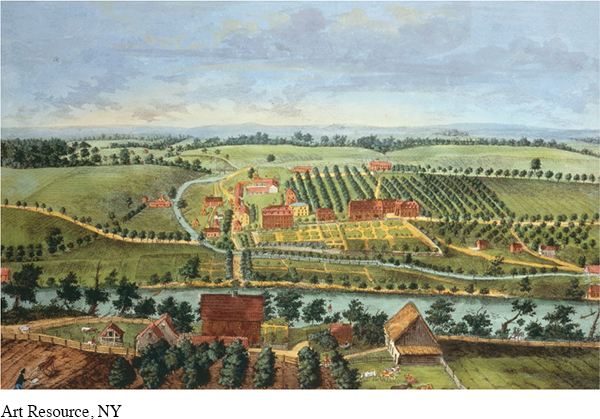Expansion and Conflict
As more and more colonists sought economic opportunities on the frontier, conflicts erupted regularly between earlier British and newer immigrant settlers as well as among immigrant groups. In Pennsylvania, Dutch, Scots-Irish, and German colonists took each other to court, sued land surveyors, and even burned down cabins built by their immigrant foes. For longtime British settlers, such acts only reinforced their sense that recent immigrants were a threat to their society. In 1728 James Logan, William Penn’s longtime secretary, complained that the “Palatines [Germans] crowd in upon us and the Irish yet faster.” For Logan, these difficulties were exacerbated by what he considered the “idle,” “worthless,” and “indigent” habits of Scots-Irish and other recent arrivals.
Anglo-Americans hardly set high standards themselves, especially when negotiating with Indians. Even in Pennsylvania, where William Penn had established a reputation for (relatively) fair dealing, the desire for Indian land led to dishonesty and trickery. Conflicts among Indian nations aided colonial leaders in prying territory from the Indians. Hoping to assert their authority over the independent-minded Delaware Indians, Iroquois chiefs insisted that they held rights to much of the Pennsylvania territory and therefore must be the ones to negotiate with colonial officials. Those colonial authorities, however, produced a questionable treaty supposedly drafted by Penn in 1686 that allowed them to claim large portions of the contested territory. James Logan “discovered” a copy of this treaty, which allowed the English to control an area that could be walked off in a day and a half. Seeking to maintain control of at least some territory, the Iroquois finally agreed to this Walking Purchase. The Delaware tribe, far smaller, was then pressured into letting Pennsylvania officials walk off the boundaries. By the time the Delaware acquiesced in the fall of 1737, Pennsylvania surveyors had already marked off the “shortest and best course,” which allowed them to extend the boundaries by at least thirty miles beyond those set in the original, and questionable, treaty.
The rapid expansion of the colonial population ensured that conflicts between Indian and colonial leaders over land rights would continue to erupt. Meanwhile migrants and immigrants on the Anglo-American frontier claimed land simply by taking control of it, building houses, and planting crops. This led to conflicts with Indian communities that considered the territory their own, with English officials who demanded legal contracts and deeds, and among immigrants who settled in the same area.
Yet some religiously minded immigrants improved relations with Indians in Pennsylvania, at least temporarily. The tone had been set by William Penn’s Quakers, who generally accepted Indian land claims and tried to pursue honest and fair negotiations. German Moravians who settled in eastern Pennsylvania in the 1740s also developed good relations with area tribes. On Pennsylvania’s western frontier, Scots-Irish Presbyterians established alliances with Delaware and Shawnee groups. These alliances, however, were rooted less in religious principles than in the hope of profiting from the fur trade as Indians sought new commercial partners when their French allies became too demanding.

Still, as tensions escalated between English and French officials in the region, conflicts intensified among the various immigrant and religious communities and with Indians. The distinct religious traditions and the dramatically different visions of Indian-settler relations drawn from these traditions also sharpened boundaries within and between colonial communities. German Moravians and Scots-Irish Presbyterians in Pennsylvania established churches and schools separate from their Quaker neighbors, while Puritan New Englanders remained suspicious of Quakers as well as other Protestant sects. Moravians and other German sects also flourished in Georgia and the Carolinas, and nearly all sought to isolate themselves from the influences of other religious and ethnic groups.
Some religious groups were isolated as much by force as by choice. While most early Irish immigrants were Protestant, by the early eighteenth century more Irish Catholics began to arrive. Then in 1745 some forty thousand Scots who had supported the Catholic monarchs in England prior to the Glorious Revolution were shipped to the Carolinas after a failed rebellion. Even long-settled Catholics, like those in Maryland, were looked on with suspicion by many Protestants. Although only a few hundred Jewish families resided in the colonies by 1750, they formed small but enduring communities in a number of seaport cities, where they established synagogues and developed a variety of mercantile ventures.
Africans, too, brought new ideas and practices to North America. Transported by force to an unknown land, they may have found religious faith particularly important. Enslaved blacks included some Catholics from regions long held by the Portuguese and a few thousand Muslims, but many Africans embraced religions that were largely unknown to their Anglo-American masters.
As religious affiliations in the colonies multiplied, they reinforced existing concerns about spiritual decline. Moreover, spiritual differences often exacerbated cleavages rooted in nationality and class. And they heightened concerns among many well-established families over the future of British culture and institutions in North America.
REVIEW & RELATE
How and why did economic inequality in the colonies increase in the first half of the eighteenth century?
How did population growth and increasing diversity contribute to conflict among and anxieties about the various groups inhabiting British North America?
Exploring American HistoriesPrinted Page 119
Exploring American Histories Value EditionPrinted Page 91
Chapter Timeline